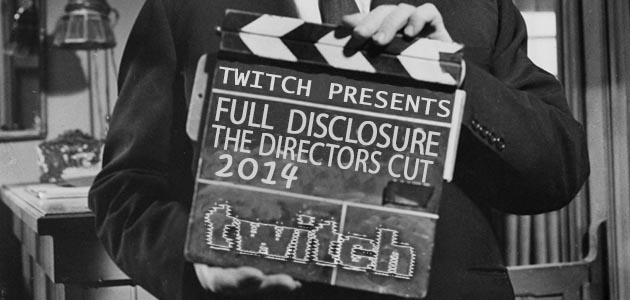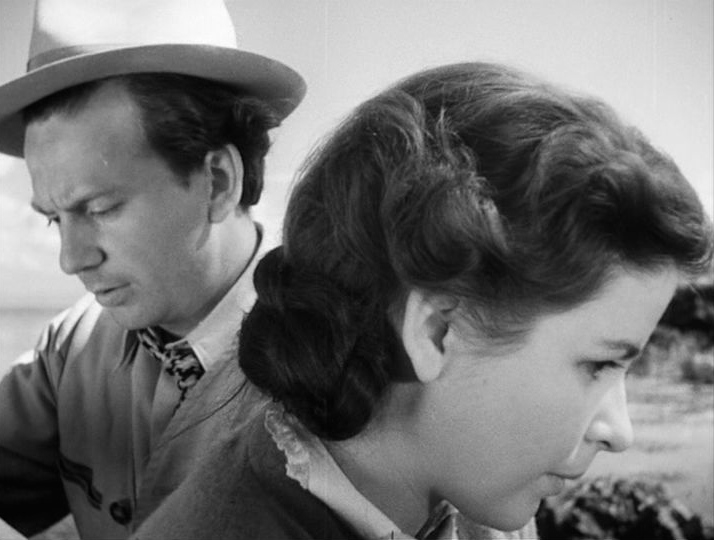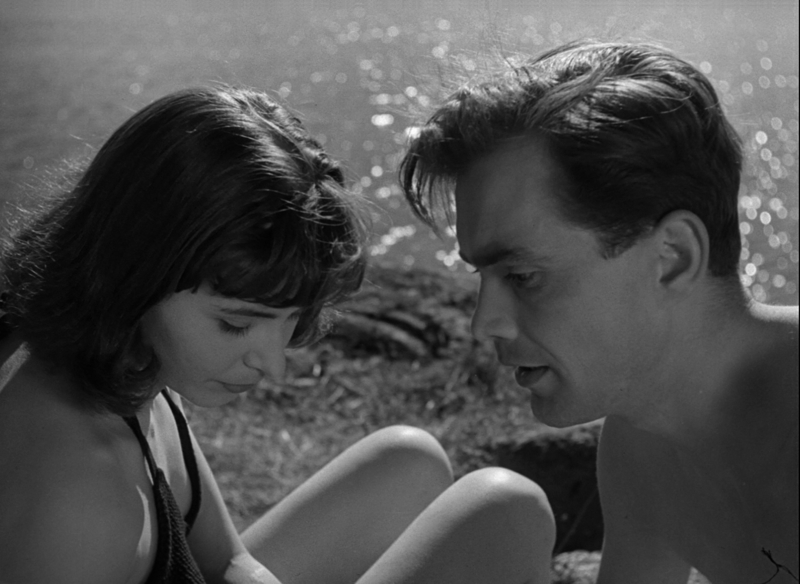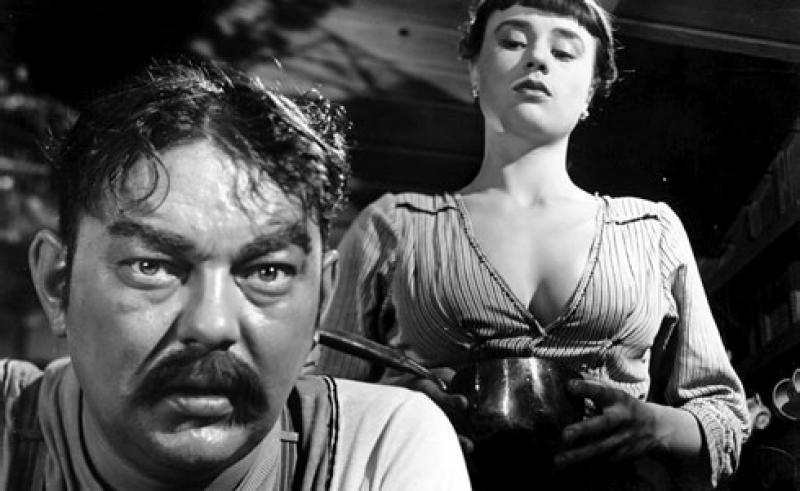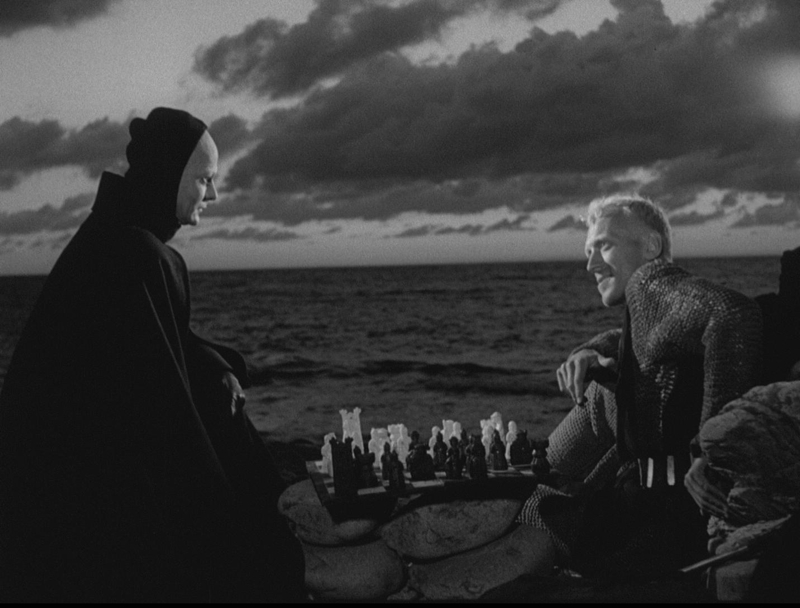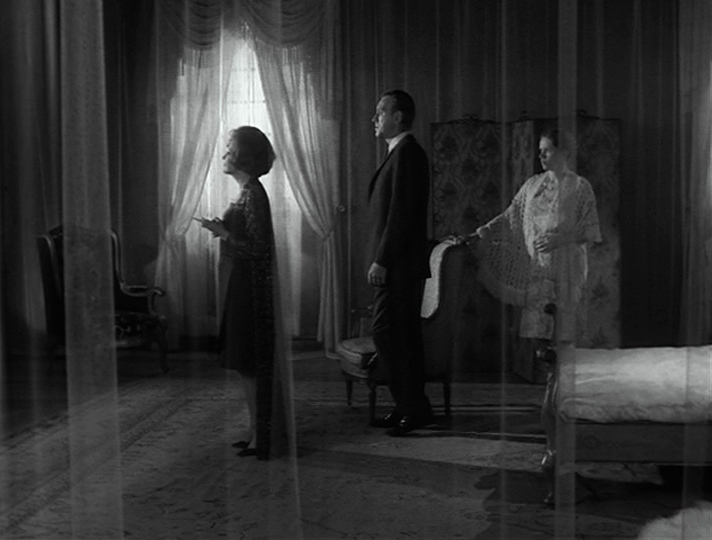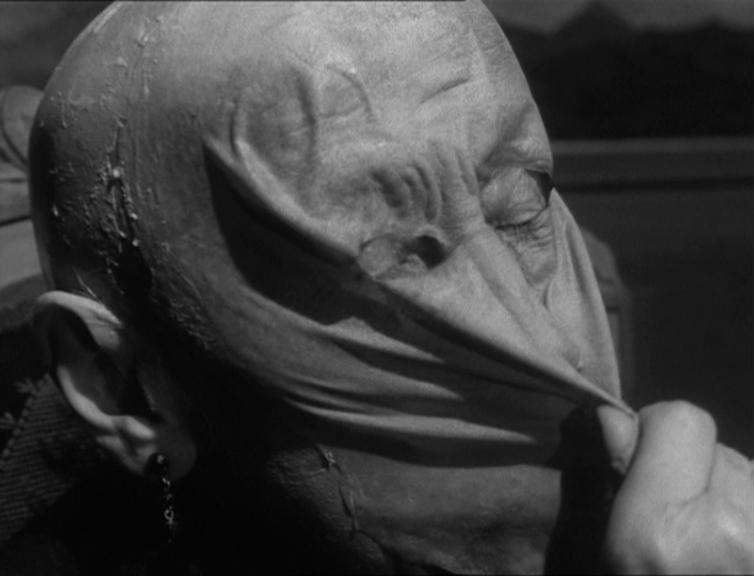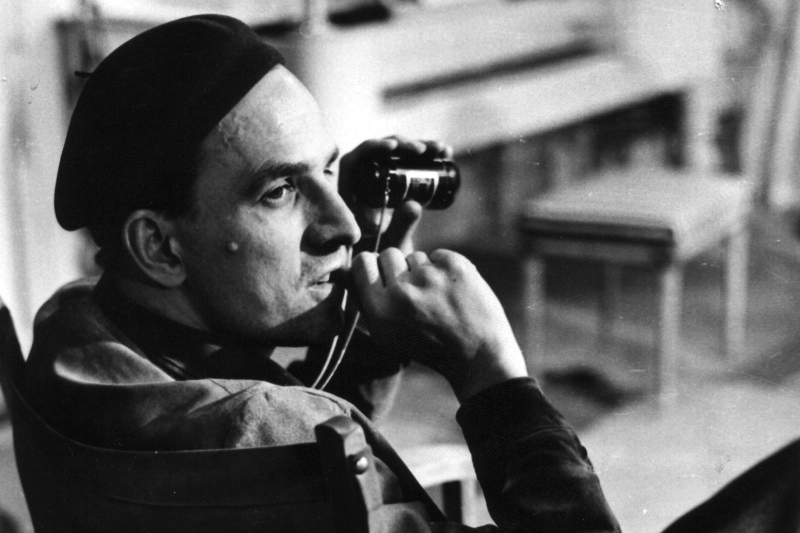Peter Martin, Shelagh Rowan-Legg, Patrick Holzapfel, Jaime Grijalba Gomez, Jim Tudor, Ard Vijn, Ernesto Zelaya Miñano and Niels Matthijs
contributed to this story.










To Joy (1950)
Peter Martin - Managing Editor
A breakthrough? Perhaps. As I explained last year, "by the time I began exploring films from outside the U.S. in the late 1970s, Ingmar Bergman had already been fossilized as a master of Cinema. ... I sampled his work, but it never provoked the kind of reaction I had enjoyed with other established filmmakers. I was left with an impression of Bergman as stoic and heavy-handed that remained unchanged when I sampled his work again in the VHS and DVD eras."
For this year's entry, I decided to start earlier in Bergman's career, and so I watched five of his early efforts via U.S. streaming service Hulu, which has a healthy selection of the filmmaker's work available. And finally I found my personal (nearly) gold standard: To Joy. Bergman's eighth film as a director follows the relationship between Stig (Stig Olin) and Martha (Maj-Britt Nilsson), violinists in the same orchestra. At first, the elusive Martha has the upper hand, but after she succumbs to Stig's odd-ball charms, it is Stig who holds sway in the relationship, and he punishes Martha for her love and devotion.
Featuring stirring scenes of orchestral music-making and the stern yet loving presence of Victor Sjöström, Bergman's mentor, as the conductor, To Joy is filled with intimate drama, leavened with lighthearted humor, and capped off with wistful regret. It's a personal reflection of a director that, finally, touched me, and made me want to explore his work again with a fresh and open mind.
Summer Interlude (1951)
Shelagh M. Rowan-Legg - Contributing writer
It’s rather embarrassing how few Bergman films I’ve seen, given his importance in cinema history. While I’ve seen all of his major works, for this assignment, I decided to locate the earliest Bergman film I could find, and ask myself, if I was watching it when it was first screened, would it encourage or discourage me from watching more? I was able to locate Summer Interlude (1951), which, to my mind, ended up being the perfect entry to Bergman under these criteria.
The story is fairly straightforward, and in typical Bergman fashion, tragic. A ballerina is sent the diary of a past lover, one with whom she had her first real affair and experience of love. Marie returns to her rural home and remembers the tale, told in flashback.
At first, this seems a rather ordinary and not necessarily exciting topic for a Bergman film. But as with most of Bergman’s films, there was a focus on interior psychology and how it manifests in the body and bodily movement, and the beautiful yet quietly haunted Swedish rural landscape. A scene early in the film shows Marie performing in Swan Lake; the camera angles are often askew and the music almost off-key, as if emphasizing her turbulent emotional state. Likewise, when recalling that fateful summer, a shot shows Marie out on row boat on her cottage lake; again, the music comes across almost as though this were a ghost story (which in effect it is), asking the spectator to stretch their viewing experience beyond the usual arthouse melodrama they might consider this to be. In addition, there is a bizarre animation sequence that makes little narrative sense, but again adds a dimension of the inner psychology and dreamscape that Bergman seemed to want to evoke.
So indeed, if I had watched this film in 1951, it would have caught my attention as something different; in a few films, more of Bergman’s signature themes, iconography and tone would emerge, and their traces can be found in Summer Interlude. For those who have not seen any of his films, this is an excellent introduction.
Sawdust And Tinsel (1953)
Patrick Holzapfel - Contributing writer
I always asked myself what makes Ingmar Bergman such a great director of cinema. Sometimes in his work you can easily sense that he was also a man of theatre. It shows in the way the dialogue is written or in the way he stages his scenes. Also the importance of psychology in his work is quite heavy. But watching the first minutes of Sawdust And Tinsel showed me that Bergman is foremost a director of dreams and nightmares. And those belong to cinema…
The dream-like sequence I am talking about comes about five minutes into the film. But even the first images of circus caravans crossing the nocturnal landscapes and the waking ringmaster of the Alberti Circus, Albert Johansson (Ake Grönberg) are part of a bigger dream. The exhausted man awakes in his caravan next to his beautiful girlfriend Anne (Harriet Anderson) wearing lipstick in sleep. She embraces him dozily. Her movement in that scene describes the feeling of watching Sawdust And Tinsel best. It is just like dreaming and being awake at the same time. Impossible to move, we let us move.
The ringmaster climbs out of the caravan and sits next to the carter. What follows is a story of love that hurts. The carter tells the ringmaster about an incident with Frost the clown at the beach. When I first watched the movie I thought that either the story of Frost will develop as the main plot of the film or that Frost is something like an abstract metaphor representing things that will happen to Albert. Well, the latter is certainly kind of true but Frost happens to be the real clown of the second rate circus company Albert is running. The story that is told about him and his wife Alma is one of the most beautiful and scary things I have seen in my life.
It starts with happy music, an innocent scene. Some soldiers are sitting at the beach flirting with a young woman. Then they start to collect some money and the laughing woman slowly undresses. Bergman cuts to cannons shooting in between his close-ups of laughing horny faces. It almost looks like a film by Sergei Eisenstein at this point but instead of agitation we feel sexual tension and fear. One of the leading soldiers grabs a young fellow and sends him away. We follow the young man running up the hill.He arrives at the circus where Frost the clown is in the middle of his act. He treats the young messenger like he was part of the show. But then he hears what the messenger has to say. The clown’s wife Alma is bathing naked with the regiment.
Everybody laughs at the clown. It is truely a nightmare. Laughing becomes gruesome in Sawdust and Tinsel. Lust is an inevitable weakness. What follows is something I would call self-reflexive sadism. The clown panics, takes the young messenger by the hand and stumbles down to the beach where he discovers his wife naked at the sea.The cheerful music and frequent laughs become irritating as the desperate clown screams (though we can not hear his voice) for his wife, tears in his eyes. This is the way love looks when filmed like a horror movie.
Suddenly it is quiet. The clown undresses himself. He is going to take his wife out of the water. The laughing grimaces reappear and we slowly feel a guilt just because we are still looking.While the clown gets his naked wife out of the water the young messenger hides their clothes. As they come out the wife realizes that everybody is looking at her. One can hear drums just like in a war film when the clown carries his wife away. If you ever wanted to see what shame looks like this is the moment in cinema history. Frost carries Alma all the way up over rough stones, stumbling in the burning sun. He wants to protect her of the gazes and he wants to protect himself.Ultimately this is an act of true love. It is just that Bergman does not believe in romantic love.
Later in the film we learn that Alma and Frost are still together. But the center of the story switches to Albert and Anne. Both of them struggle with their relationship and profession. Anne is seduced by a local theatre actor and Albert suddenly feels the urge to return to his former wife and child. At the same time Bergman tells, just like John Cassavetes did with a strip club in The Killing of a Chinese Bookie, about the day-to-day fight of running a small circus.
But surely the story about Frost and Alma is the harsh magic cinema can deliver. It was only here that I cried in the first ten minutes of a film.
The Seventh Seal (1957)
Winner of the Jury Special Prize at the Cannes Film Festival
Jaime Grijalba - Contributing writer
Ingmar Bergman not only demonstrates a swift and incredible hand by making a movie that manages to move and entice the thinking of its viewers, but also displays his knowledge of Shakespearean lore, and the tribulations and important themes present in the Bard's works, specifically his most magnificent play (in my opinion), Hamlet.
It is no wonder that Bergman must've had an obsession with the Danish play, and it's clear in the physique of the protagonist of The Seventh Seal that he is mostly inspired in the classic figure of the young Hamlet, coming back from some kind of emotional turmoil that left him with doubts regarding his place in the world, his own life, God and his sanity. He plays chess with Death just as Hamlet plays around with his fake insanity (or not so faked illness, according to some interpretations). He moves forward through time and place, trying to get the most from a match he knows he can't win - Death or Insanity will inevitably come to claim him. Many of the passages in the movie remind you of the long monologues regarding the state of the flesh and how probable it is that there's nothing after death.
It is clear also with the mention of Elsinor that the movie wants to be a retelling of Hamlet without the murders and with more of the witty humor that Shakespeare loved to include. In one of the scenes in the forest, there's a fight with words and puns as well as rhetoric between an actor and a Blacksmith, over a woman, something that reminds you of the lighter and mostly worded fights in "A Midsummer's Night Dream", with obscenities and innuendos included!
I totally expected a boring film, and this isn't one, it manages to entice and make the viewer grow in his contemplations. Some might find it pretentious, but most of the questions posed here are valid, and while some might've already found the answer to them, I think that it's fair to give them another shake. I must say I got more from this Shakespeare palimpsest than I could ever have expected from such a lauded and revered film.
Through A Glass Darkly (1961)
Winner of the Academy Award for Best Foreign Language Film, nominated for the Academy Award for Best Original Screenplay
Jim Tudor - Contributing writer
The adage “show don't tell” gets kicked around an awful lot when it comes to movies. And yet, a good director and/or a good actor, when dealing with choice material, can break this rule, and come out ahead. Case in point, writer-director Ingmar Bergman routinely made “tell don't show” work as cinematic high art.
Take his stark 1961 “chamber drama”, Through a Glass Darkly, the first of his “Silence of God” trilogy, consisting of emotionally raw tales of troubled people in spiritual crisis. Here, he's got only four actors; all absolutely choice. He magically somehow cloisters them on some desolate Scandinavian island, hands them a screenplay, and manages to procure some of the most soul-searing exchanges and moments.
Harriet Andersson is Karin, who's been diagnosed with a form of degenerative schizophrenia, complete with her communing with God's messengers. Her father (Gunnar Björnstrand), a famous writer, admits shame in his urge to mine her terrible circumstance for story material. Her lover (Max von Sydow) doesn't take well to that at all. Meanwhile, her teenaged brother (Lars Passgård) must look on, sexually frustrated. All of this is hashed out in long takes, the camera unafraid to linger, to dwell, on the studied face of whomever is speaking.
The great cinematographer Sven Nykvist, still new to the director with whom he would become most closely associated, realizes the visual tone and mood of what Bergman's up to with admirable intensity. And yet the light – that light! - is so soft, so radiant...so Godly...
Which brings us to the denouement: Through a Glass Darkly, while immaculate and never boring, remains non-essential Bergman. Despite Andersson's unforgettable and convincing every-which-way performance, it doesn't sell the argument that mental illness is the ideal springboard for talking about God in narrative fiction. It is, however, perfectly logical that Karin's fervor, whether delusional or not, would force the issue in the minds of the other characters. And that it most certainly does, leading to a much darker but similar landing place as Woody Allen's Magic in the Moonlight.
Even as Bergman ventures through this glass darkly into his trilogy about God's silence, he's still keen on telling all about life's overwhelming cracks – and the magic light that shines in through them.
Hour Of The Wolf (1968)
Ard Vijn - Contributing writer
I have heard about Ingmar Bergman time and time again, as the man is a true legend among European filmmakers. But it wasn't until last year's Full Disclosure that I actually saw one of his films. That was The Seventh Seal and it wasn't at all what I expected. Less heavy, with more sarcasm in it.
The same can be said about Hour Of The Wolf, which was "sold" to me by my brethren as a horror film, and a pretty incomprehensible one at that. But if you have seen films like Videodrome or Kotoko, the incomprehensibility claim is false, as is the horror one. What I saw was a well-acted drama about an artist with severe mental problems, unable to avoid his relapse into insanity. Max von Sydow and Liv Ullman are great here, and all others are the stereotypical non-entities they are meant to be, reflections of how the artist perceives societies opinions about him.
For decades we have the sub-genre of the 'mindfuck' movie, and like Roman Polanski's Repulsion, this is an early precursor. A surprisingly palatable one too, if you can stand the gloom before the dawn.
Hour Of The Wolf (1968)
Ernesto Zelaya Minano - Contributing writer
Ingmar Bergman wasn’t the sunny kid in the class, was he? From my limited experience with his movies – mostly through parodies like The Last Action Hero and Bill & Ted’s Bogus Journey – I can see that his films are morose, downbeat and full of weighty existential themes; definitely not made for casual viewing. Hour of the Wolf, despite being billed as a somewhat-horror movie, is no different.
So what we have here is an artist and his young wife spending some quality time together on a remote island, except that in Bergman’s hands, this is the most miserable vacation you’re ever likely to see. The island is barren and practically empty, the artist is clearly haunted by a host of demons and is on the verge of losing his mind, and the long-suffering wife is trying to keep it together while watching her husband slowly unravel.
Poor Liv Ullmann; as she painfully speaks with those sad eyes, you just want to reach through the screen and give her a hug.
The atmosphere is thick with dread – if this movie were in anything other than black and white, it would be completely ruined – and that’s even before the crazies come knocking. It’s at this point, when the character of Borg starts going down the rabbit hole, that any semblance of coherence is gone. You’re left on your own to interpret what’s going on, if all that’s onscreen is just the ramblings of a madman or something else; that is, if you’re so inclined.
I was left scratching my head and feeling profoundly sad afterwards. I’m not even sure that rewatching would help. It’s a depressing, uncomfortable watch, and when it ends as it started, with Ullmann tearfully addressing the camera asking you, the viewer, to make sense of everything that transpired, I wanted to ask the same thing: what exactly happened on this island?
Hour Of The Wolf (1968)
Niels Matthijs - Contributing writer
It's been a while since I watched a Bergman film. A couple of years ago I tried to get acquainted with his most famous films, but we didn't really get along. Persona had potential, but Wild Strawberries, The Seventh Seal and Fanny And Alexander were completely wasted on me. So I figured I'd better look elsewhere for this month's assignment. Eventually I landed on Hour Of The Wolf, Bergman's "horror" film.
On the whole, Hour Of The Wolf reminded me quite a lot of Polanski's Repulsion. The story about an artist moving down to a small island to focus on his work shows obvious parallels with Kubrick's (or King's) The Shining. But those hoping for a full-blown horror film will be left hanging.
Hour Of The Wolf is more psychological thriller than horror, which explains the tepid first hour. Once again Bergman is more occupied with underlying themes and dialogues, completely neglecting typical genre elements. It isn't until the final 30 minutes that some kind of creepiness is attempted, but it's too little too late.
Liv Ullmann is a horrible actress, Von Sydow is better but fails to bring his character to life. While attempts are being made to crank up the tension, Bergman simply fails to make it work. All that is left are some artsy types getting fretty about themselves on an island.
Bergman and I just don't get along very well.

Around the Internet
Recent Posts
THE COPENHAGEN TEST Review: Under Surveillance
Friday One Sheet: The Best Posters of 2025
THE PLAGUE Review: Zero for Conduct Again
Leading Voices in Global Cinema
- Peter Martin, Dallas, Texas
- Managing Editor
- Andrew Mack, Toronto, Canada
- Editor, News
- Ard Vijn, Rotterdam, The Netherlands
- Editor, Europe
- Benjamin Umstead, Los Angeles, California
- Editor, U.S.
- J Hurtado, Dallas, Texas
- Editor, U.S.
- James Marsh, Hong Kong, China
- Editor, Asia
- Michele "Izzy" Galgana, New England
- Editor, U.S.
- Ryland Aldrich, Los Angeles, California
- Editor, Festivals
- Shelagh Rowan-Legg
- Editor, Canada


